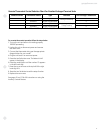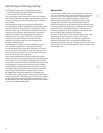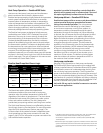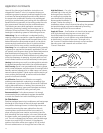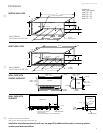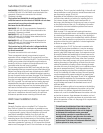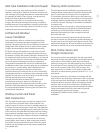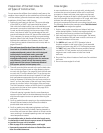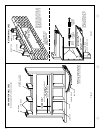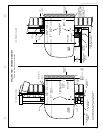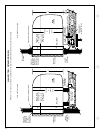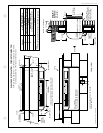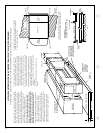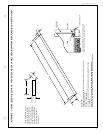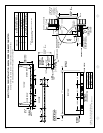
25
geappliances.com
Do not remove the stiffener from inside the wall case or the
weather closure panel from the outside face of the wall case
until the outdoor grille and chassis are ready to be installed.
Installation of Wall Case in Wall Opening
1. Position the wall case into the wall. The room-side edge
of the RAB71A or RAB77 wall case should be at least
flush with the finished wall for line-cord installations and
permanent- connection installations when no sub-base
is used, and should project into the room at least 2-3/8"
when a sub-base is used. The outside edge of the wall
case should extend at least 1/4" beyond the outside wall.
This is necessary for proper caulking, to prevent sealing
the drain holes in the rear flange of the wall case, and to
facilitate the installation of an accessory drain, if used.
If the minimum exterior dimensions are not met, refer to
pages 30 and 31.
The wall case should be level from side to side and
from level to 1/4 bubble tilt to the outdoors. The
condensate disposal system in the unit is designed
to dissipate the condensate water generated
during cooling operation in accordance with ARI
standards and actually uses this water for maximum
unit efficiency. A level unit will also ensure proper
performance of the Internal Condensate Removal
(ICR) system optional on heat pump units.
2. The wall case should be secured to the wall at both sides.
Use a minimum of two screws or other fastening device
on each side. See Figure 2 on page 26. Mark the wall case
on each side 2" from the bottom and 2" from the top at a
point where basic wall structure is located. Drill wall case
and use fasteners appropriate for wall construction. All
holes for fasteners in the side of the wall case must be at
least 2" up from the bottom of the wall case. Never locate
screws or put other holes in the bottom of the wall case.
The ONLY exception is when an RAD10 drain kit is installed
to connect to an internal drain system. See page 36 for
RAD10 drain kit information.
If the wall opening is greater than the case dimensions,
spacers must be used on the sides between the wall case
and the wall support structure to prevent distorting the
wall case.
3. Caulk or gasket the entire opening on the outside between
the wall case and exterior wall surface (four sides) to
provide total water and air seal.
4. Caulk or gasket room-side opening between wall case
and interior wall surface (four sides). Opening beneath or
around the wall case can allow outdoor air to leak into the
room, resulting in increased operating costs and improper
room temperature control.
Care should be taken in location of electrical supply entry
in relationship to wall sleeve to assure access to receptacle
or junction box once unit is installed.
•Refertopage43formaximumpowercordlength.
• Permanentlyconnectedunitsclosetofinishedfloormust
allow for conduit clearance.
Case Angles
In some installations, such as curtain walls, window walls,
or where the structural material of the wall is insufficient
to support or fasten wall case, case angles may be used.
Case angles are pieces of steel or other material of similar
structural strength that are formed to a 90° angle, with holes
to fasten the case angle to the wall case and to the
structural component of the wall surrounding the wall case.
The following describes the procedure when field-fabricated
and -installed case angles are applied.
1. Position case angles around top and sides of wall case
at the desired location. Position case angles vertically on
each side of wall case to provide a level installation.
2. Mark wall case through holes in case angles. The lowest
hole on the sides of the wall case must be a minimum of
2" above the bottom of the case.
3. For RAB71A wall case, drill 5/32" diameter holes at
locations marked on wall case in Step 2, and assemble
angles to wall case using #10 x 1/2" self-tapping screws.
For RAB77 wall case, follow the same procedure except
use a #10 x 1/2" bolt, washer and nut to attach case
angles to case. Install screws or bolts from inside
wall case.
4. Do not drill any holes in bottom of wall case. Do not distort
wall case.
5. Do not use case angles for a lintel.
Preparation of the Wall Case for
All Types of Construction,



